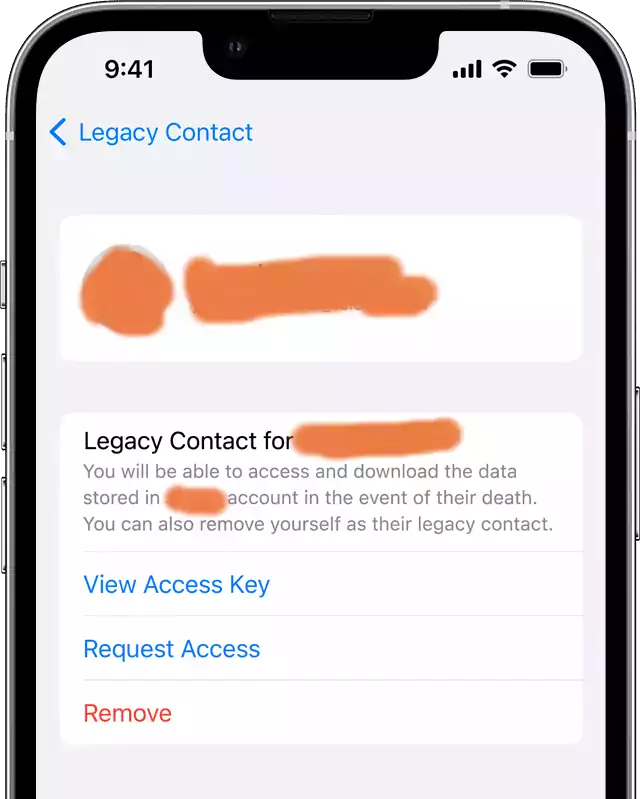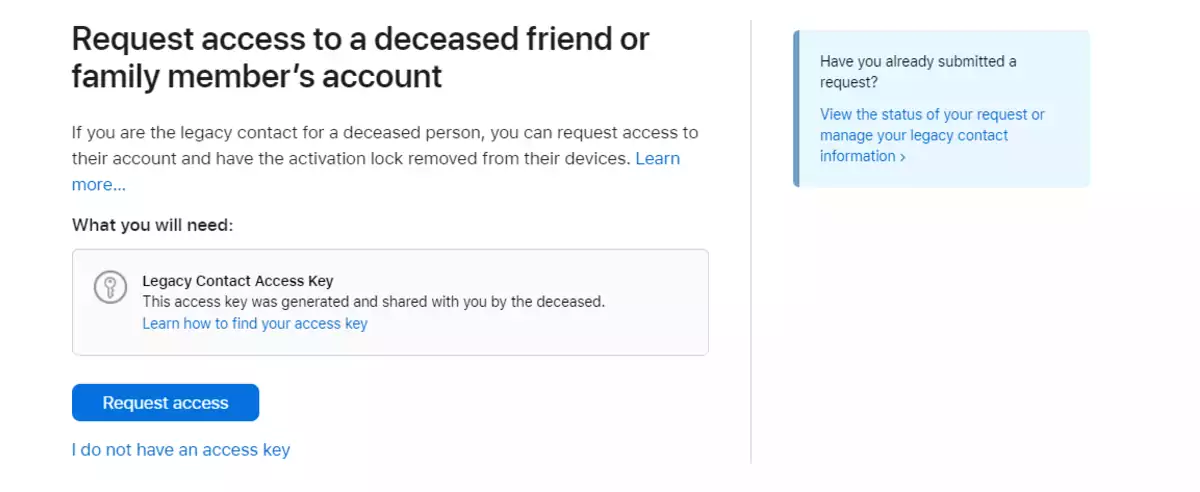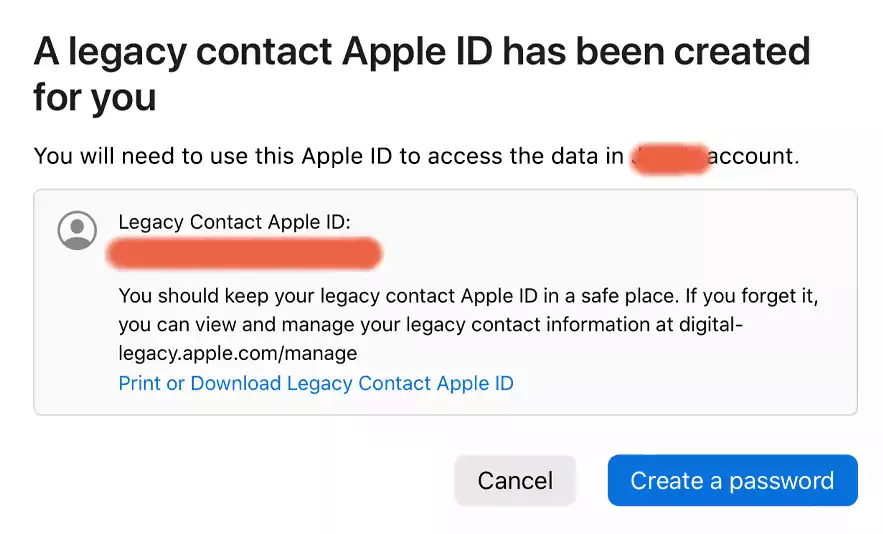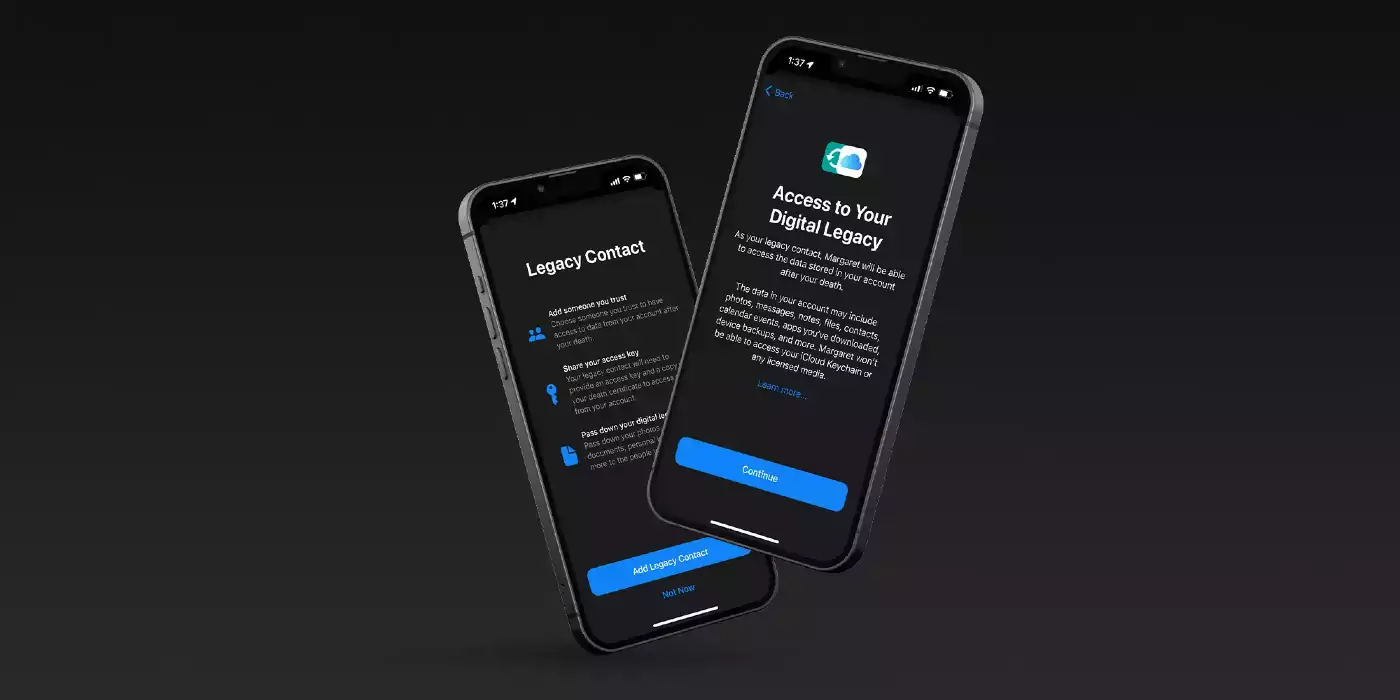Apple released iOS 15.2 the other day and one of the main features was the initial release of Digital Legacy, an important feature to ensure that whatever data you’ve amassed from your years of using Apple devices and that’s stored under your Apple ID – and backed up to Apple’s cloud – isn’t lost forever when you die.
Since the assumption is that you’ve left this mortal coil, it gives people you have designated full access to virtually everything stored with the ID. The list includes, among other things, iCloud-stored photos, notes, email, contacts, calendars, iCloud Drive files, backups, health data, and even Safari Bookmarks.
How to set up Digital Legacy
Digital Legacy allows you to designate up to five people as Legacy Contacts so they can access your iCloud account and personal information in the event of your death.
On the iPhone or iPad, you go to Settings and find Password & Security, which is found when you tap on the tile with your name on, at the top of the front page of Settings.
Here, providing you’re running iOS 15.2, you’ll see an entry marked Legacy Contact. Add the details of the person you’d like to have access to your iCloud content after you’re gone.
The next step is to let your chosen contact know about this, and to do this, you can send them a message via the Messages app.
Assuming they accept, then the access key they’ll need is automatically stored in their Apple ID settings. They need to have iOS 15.2 on their iPhone, too, by the way. They’ll need the access key to get into your account when you have passed.
If they don’t have the software yet, you could alternatively print the access key and give it to them, or send a PDF. And you can save a copy with your will.
You can name up to five Digital Legacy contacts, so you just follow the same process for each.
Data that a Legacy Contact can access
Adding a Legacy Contact is the easiest, most secure way a user can give someone they trust access to the data that’s stored in their Apple account if they pass away.
Apple does not let you choose what a Legacy Contact can and cannot see from your data.
The data that a Legacy Contact can access depends on what the Apple ID account holder has stored in iCloud and in their iCloud Backup. For example, if they kept all of their photos on a third-party site, these photos aren’t stored by Apple so they won’t be in their Apple ID data.
Data that a Legacy Contact may be able to access includes:
- iCloud Photos
- Notes
- Contacts
- Calendars
- Reminders
- Messages in iCloud
- Call history
- Files stored in iCloud Drive
- Health Data
- Voice Memos
- Safari Bookmarks and Reading List
A legacy Contact can also access an iCloud Backup, which may include downloaded App Store apps; photos and videos stored on the device; device settings and other content backed up in iCloud and not excluded.
Data that a Legacy Contact cannot access
Data that isn’t available to a Legacy Contact includes:
- Licensed media, for example, films, music and books that the account holder has purchased
- In-app purchases, for example, upgrades, subscriptions, game currency or other content that was bought inside an app
- Payment information, for example Apple ID payment information or cards that have been saved for use with Apple Pay
- Information stored in the account holder’s Keychain, for example, Safari usernames and passwords, internet accounts (used in Mail, Contacts, Calendar and Messages), credit card numbers and expiry dates, and Wi-Fi passwords
How to Request access to an Apple account as a Legacy Contact
A Legacy Contact is someone you choose who can access the data in your Apple account after your death. You don’t need to have an Apple ID or an Apple device to be added as a Legacy Contact, but you must be over the age of 13 to request account access after someone has passed away.
To request access as a Legacy Contact, you must have:
- The access key that your loved one created when they chose you as a Legacy Contact
- Your loved one’s death certificate
For security, Apple reviews requests from Legacy Contacts and only provides access to account data after verifying the required information.
After your request has been approved, you’ll receive a special Legacy Contact Apple ID to access the account data. The account holder’s original Apple ID will no longer work and Activation Lock will be removed on any devices using their Apple ID.
You’ll have access to the legacy account for three years from when the first legacy account request was approved, after which the legacy account will be deleted permanently.
If your loved one has added more than one Legacy Contact, the other contacts can also access the legacy account and make decisions about account data, including deleting it permanently.
If you’ve been added as a Legacy Contact
When someone adds you as a Legacy Contact, an access key will be created and shared with you. Make sure you keep this access key in a safe place because you must have it to request access as a Legacy Contact if your loved one passes away.
- If your Apple device is running iOS 15.2, iPadOS 15.2 or macOS 12.1 or later, and someone in your Family Sharing group adds you as a Legacy Contact or you receive a Legacy Contact request, the access key will be stored in the Apple ID settings on your device automatically.
- If your Apple device has older software and you receive a Legacy Contact notification, you’ll need to update to iOS 15.2, iPadOS 15.2 or macOS 12.1 or later so you can save the access key in your Apple ID settings.
- If you don’t have an Apple device or can‘t update your Apple device, you can ask your loved one to send you the access key by email or text message, or they can print a physical copy for you.
- In some cases, someone can add you as a Legacy Contact but choose to keep a copy of your access key with their estate planning documents. In this case, you may not receive the access key until after they’ve passed away.
However you receive the access key, it’s a good idea to keep an additional copy of it in a safe place so you can find it later.
If someone has added you as a Legacy Contact but you’d prefer not to be one, you can talk to them about it or simply choose not to use the access key if they pass away. If Legacy Contact information is saved in your Apple ID settings, you can remove yourself as a Legacy Contact – which will also delete the access key – at any time.
Where to find your Legacy Contact access key
If your Legacy Contact access key is saved on your Apple device, you can find it easily in your Apple ID settings. If your loved one has given you a copy of the access key or has sent it to you a different way, you’ll need to find it in your files.
If your access key is saved in your Apple ID settings
On your iPhone, iPad or iPod touch:
- Go to Settings, then tap your name.
- Tap Password & Security > Legacy Contact.
- Tap the person’s name to see more options, including viewing the access key or starting an access request.
On your Mac:
- Choose Apple menu > System Preferences, then click Apple ID.
- Click Password & Security.
- Click Manage next to Legacy Contact settings.
- Click Details next to the person’s name to see more options, including viewing the access key or starting an access request.
If your access key is saved as a document
If your loved one has added you as a Legacy Contact and given you a copy of the access key, you’ll need to find the access key in your files. They may have sent it to you by email or text message, or they may have printed it out and given you a physical copy. It’s also possible that they saved a copy of your access key with their estate planning documents, and you’ll only receive it after they’ve passed away.
If you can’t find or don’t have an access key
To protect the privacy and security of the Apple ID account holder, Apple can’t access or replace an access key that’s been lost or misplaced.
How to request access as a Legacy Contact
If someone who’s added you as a Legacy Contact passes away, you can request access either directly on your Apple device that’s running the latest software, or on the internet.
Before you get started, make sure you have:
- The access key that your loved one created when they added you as a Legacy Contact
- Your loved one’s death certificate
Save your access key in a secure place because you’ll need it again when you sign in to the Legacy Contact Apple ID after your request has been approved.
Apple will send you an email confirming that your request has been received. For security, they will also send an email to the Apple ID for which you’ve requested access. Apple reviews and verifies each request. You will be notified by email when the review has been completed or if more information is required.
The death certificate can be in PDF, PNG, TIF, JPEG or GIF file format, with a resolution of at least 300 dpi or 3300×2550 pixels. Each page must be flat and fully legible; all four edges of the page must be visible.

Request access in Apple ID settings
If your access key is saved in your Apple ID settings, you can start a request directly on your device.
On your iPhone, iPad or iPod touch:
- Go to Settings, then tap your name.
- Tap Password & Security > Legacy Contact and tap the person’s name.
- Tap or click Request Access and follow the instructions to upload the death certificate.
On your Mac:
- Choose Apple menu > System Preferences, then click Apple ID.
- Click Password & Security.
- Click Manage next to Legacy Contact settings.
- Click Details next to the person’s name.
- Click Request Access and follow the instructions to upload the death certificate.
Request access on the internet
If you don’t have access to an Apple device, but you have the access key and death certificate, you can start your request on the internet.
- Go to Digital Legacy – Request Access.
- Click “Request access” and sign in with your Apple ID or provide the requested contact information.
- Follow the instructions on the website to verify your identity, enter your access key and upload the death certificate.

You can check the status of your request at Digital Legacy – Manage.
After your Legacy Contact request has been approved
After your request has been verified and approved, you’ll receive an email with more details and instructions. The email will include a special Legacy Contact Apple ID for your loved one’s account. You’ll be asked to enter your access key again and to confirm your contact information. Then you’ll create a password and set up two-factor authentication for the Legacy Contact Apple ID.
You can manage this information at Digital Legacy – Manage.

After your request has been approved, Activation Lock will be removed from devices using your loved one’s original Apple ID. These devices will need to be restored to factory settings before they can be used with another Apple ID.
Access a Legacy Contact Apple ID
After you’ve created a password and set up two-factor authentication, you can use your Legacy Contact Apple ID to sign in to the account on the internet at iCloud.com or download the account data at privacy.apple.com.
Or you can use the Legacy Contact Apple ID to sign in on an Apple device, just like you would with any other Apple ID. You can also use the Legacy Contact Apple ID to restore an iCloud backup on an Apple device.
You may be asked to enter your Legacy Contact access key for end-to-end encrypted data, such as health data, voice memos and more.
Make sure you use the Legacy Contact Apple ID to sign in. Don’t use the original account holder’s Apple ID or your personal Apple ID.



